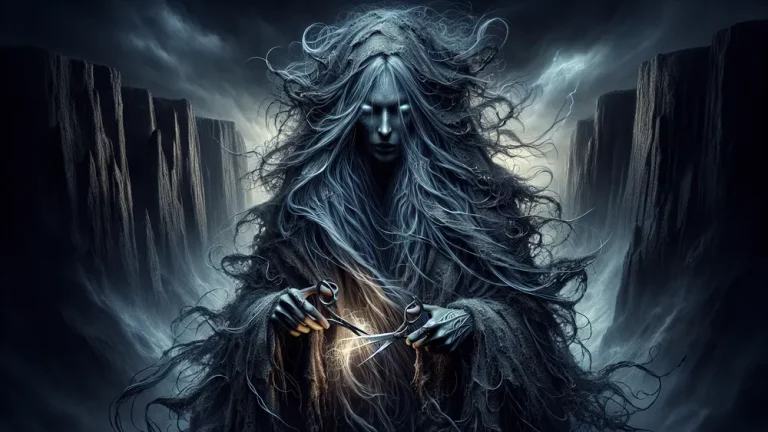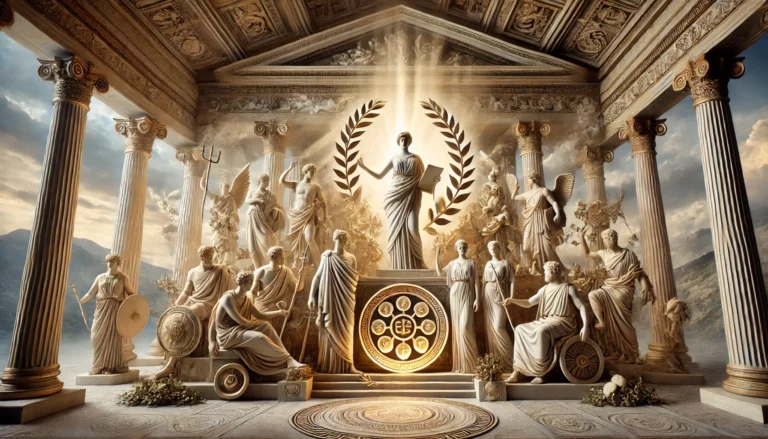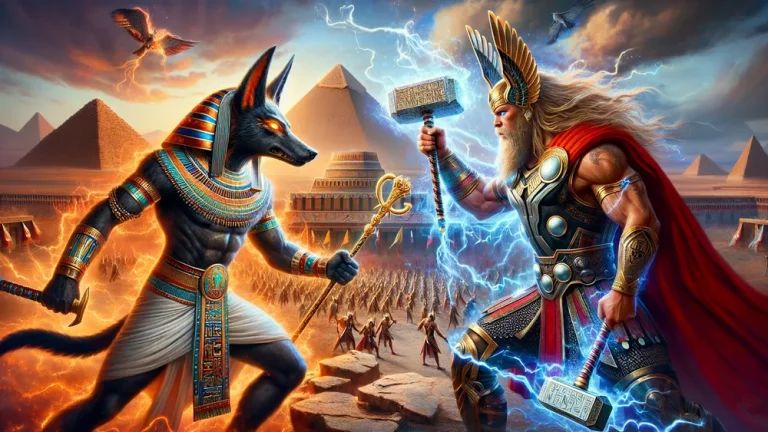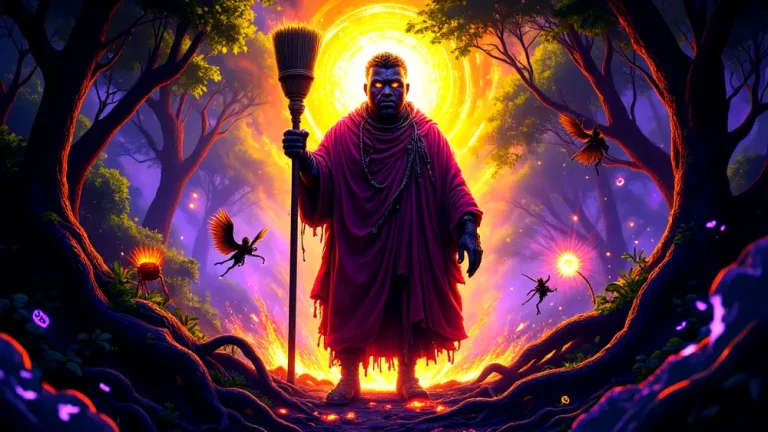Nymphs: Serene Nature Spirits Of Greek Mythology And Lore
In the calm world of Greek mythology, nymphs exist as delicate beings tied deeply to the parts of nature that matter most, like forests, rivers, and mountains. These smaller gods, who mean so much to natural parts, reflect the old Greeks’ deep respect for the natural world and many of its wonders.
Key Points:
- Nymphs are nature spirits in Greek myths, related to places like rivers and forests.
- They are like guardians reflecting the Greeks’ respect for the environment.
- Types of nymphs include Naiads (water), Dryads (trees), and Oreads (mountains).
- They are known for beauty, not fully immortal, and age slowly.
- Nymphs play roles in Greek tales, like Echo’s love story with Narcissus.
- Nymphs appear in art and music, symbolizing nature’s beauty.
- They are part of Greek religious practices, worshiped at natural sites.
You might see nymphs as guardians of nature’s beauty, much like a caretaker naturally linked to their place. People really can’t resist them or their pull, and they have been fascinating and inspiring for centuries, appearing in many myths and stories.
As you go through this exploration, you might uncover how stories and presences of nymphs hang around over time, meaning the Greeks’ views of harmonious divine in their natural settings. This blog post will guide you to understand lots about their parts and their lasting place in culture.
Nymphs: Overview and Key Facts
| Key Aspect | Description |
|---|---|
| Definition | Nymphs, seen in Greek stories as lesser goddess figures, usually relate to particular parts of nature like rivers, trees, and mountains. |
| Nature Connection | They are tied to specific parts of the natural world, representing spirits or figures that stand for these natural things. |
| Types of Nymphs | Naiads (freshwater), Dryads (trees), and Oreads (mountains) are some types, and each nymph belongs to a specific part. |
| Characteristics | Nymphs often mean beauty of young women; they are known as kind beings capable of influencing both nature and people. |
| Cultural Significance | Part of Greek beliefs and practices; nymphs had an essential role, and they were often asked for help or good things related to the natural world. |
| Role in Mythology | They come up a lot in myths, connecting with gods, heroes, and people, and taking on roles in stories of love, change, and adventure. |
| Immortality | Though not forever living like the big gods, nymphs last a long time; they age slowly but might die under some situations. |
Getting to Know Nymphs
To fully grasp the essence of nymphs and their special charm, it’s important to look further into where they come from and see the different kinds and roles they hold in Greek stories. Each one is as captivating and varied like the elements they come from.
What are Nymphs?
In Greek tales, nymphs are lesser god-like figures who are strongly tied to the natural world and appear as spirits of particular things in nature. They can be thought of as eternal guardians, forever caring for rivers, trees, mountains, or bits of the landscape, which is a bit like how a park ranger looks after a national park now. As otherworldly beings, nymphs appear as youthful and beautiful maidens, and they mean to show the divine heart of nature. For a clearer picture, here are some key facts about nymphs:
- Nature Affiliation: Each kind of nymph is tied to a specific part of nature or spot, such as water, trees, or mountains.
- Divine Yet Mortal Affinity: Unlike the main gods in Olympus, nymphs could grow older and weren’t truly immortal, but they lived a really long time.
- Roles in Mythology: In various myths, nymphs often took part and interacted with gods, humans, and heroes, where their effect could range from being helpful to causing change.
Nymphs in Greek mythology are nature-connected beings who look after specific natural places and interact with gods and humans, living long lives but not being truly immortal like the main gods.
Different Types of Nymphs and Their Domains
In Greek stories, nymphs are grouped into various types, each one closely linked to a part of nature it stands for. These types are based on where they live or what they affect. For example, Naiads are well-known as water nymphs, living in fresh water like rivers and springs.
These nymphs are much like guardians of these water areas, similar to a marine biologist, who watches over and cares for water life today. Dryads, another kind of nymph, are linked to trees or forests, especially oaks, showing a special link to a particular tree.
Think of them as protectors of the forest, keeping the woods alive, a connection deep in Greek culture between these spirits and trees’ long lives. Besides Naiads and Dryads, there are other kinds, each having its own distinct domain. Oreads are mountain and cave nymphs, meaning the greatness and mystery of big landscapes and hidden places.

They seem like the very look and feel of rocky mountain faces, quite like the unchanging and amazing presence of these big landforms. Also, there are Nereids, sea nymphs, living in the Mediterranean Sea, often appearing as mermaid-like figures. They interact with seapeople and play key parts in sea stories.
This set of types shows how jumprse the Greek land is and the deep stories Greeks created to explain and make every natural thing in their world seem alive and divine. Each type of nymph, with its own domain, helps us see how Greeks saw and loved nature as a living part of their world.
Nymphs in History
When we move from knowing the kinds and roles of nymphs, we can check out their historical importance and see how these interesting beings were part of ancient Greek religion and storytelling.
Nymphs in Ancient Greek Religion
In old Greek beliefs, nymphs played an important role as go-betweens for people and gods, representing the special nature of the world around them. Not like the all-powerful gods on Mount Olympus, nymphs appeared more like local deities, deeply part of the spiritual places where people lived and worshipped.
You can think of them as spiritual caretakers of natural happenings, with worshipping happening at natural sites – such as in groves, springs, or caves – marked by small altars or shrines. Here, people would leave prayers, pour drinks, or give gifts hoping for favor or help.
Some ceremonies had them singing songs or doing dances to honor these beings, which might look similar to traditions around the world where the land itself is alive with divine beings. Their key place in belief systems meant ancient Greeks noticed how linked they were to nature, finding the divine not just in big temples but also in the ground and water around them.

Nymph Stories
In Greek myths, nymphs have important parts in stories and legends, showing many feelings and driving story changes. There are stories with changes, love that isn’t returned, and meetings with gods and people, which means the mix of human and divine lives in Greek ideas. A well-known story is about Echo, a mountain nymph whose sad ending happened because of her love for Narcissus.
He was a person who couldn’t return her feelings. Her story means longing and loss, seen clearly by the fact only her voice was left after she wasted away from a broken heart. Think of Echo’s story like a warning for today, where love that isn’t returned leaves a lasting, though unseen, mark.

A different famous story tells of the river god’s daughter, Daphne, who turns into a laurel tree to get away from Apollo’s strong chase, showing changes and what happens when godly wants mix with people’s choices. In these tales, nymphs don’t just stand in the background but are strong, important beings who can shape their own futures, challenging the gods’ wishes. To get a better idea of their narrative significance, imagine nymphs as characters representing nature’s voice – constant, inviting, and always changing with their surroundings. Here’s a table to help you explore some key nymph stories:
| Nymph Name | Story Theme | Key Elements |
|---|---|---|
| Echo | Unreturned Love and Loss | Love for Narcissus, punished by Hera, voice stays |
| Daphne | Change and Escape | Chased by Apollo, becomes a laurel tree |
| Arethusa | Running Away and Help | Fled from Alpheus, Artemis changes her into a spring |
| Calypso | Yearning and Hold | Keeps Odysseus on Ogygia, longs for company |
Famous Stories with Nymphs
After we look at the interesting parts that nymphs play in myths, let’s jump into some famous tales that focus on these magical beings and their lasting effect on Greek mythology.
Echo’s Story: Love and Loss
Echo’s story is in Greek myths, which includes themes like love, heartbreak, and punishment. One version says Echo was a mountain nymph with a beautiful voice and could tell great stories. But her tendency to talk caused problems when she kept Hera, queen of gods, busy with her endless talking while Zeus went after other nymphs.
Hera punished Echo, making her only say the last words told to her, taking away her ability to talk freely. Her life changed a lot, from being free in speaking to only repeat sounds, and people today might understand if they feel unseen, talking only with others’ voices. Her sad love story happens when she meets Narcissus, a very handsome man who loves his reflection.
Unable to use her own words, Echo only says Narcissus’ words back to him when trying to express her feelings. This created an emotional situation, like a talk stuck in reflections, where Echo just mirrored Narcissus’ words. This part means a deep feel of being alone and wanting, with Echo having what many characters in stories and life face – trying to talk but stuck by outside forces.

Even though her love was never returned, Echo’s part in myths means the strong feeling of unreturned love – a theme that lasts over time. More than that, Echo’s story is a lesson about what happens from our actions, seen in how she faded from sadness until only her voice was left in echoes across large spaces.
Her story means the lasting pain from love and loss, a point often explored in myths, that love comes with its own difficult parts and challenges.
Echo’s tale is about her transformation from a lively nymph into a voice that only repeats others, highlighting feelings of unreturned love and the lasting consequences of one’s actions.
The Tale of Daphne
Daphne’s story is interesting. It mixes themes like being chased, change, and showing control against gods’ wants. In myths, Daphne was a naïve river nymph, daughter of a river god, Peneus. It was her beauty Apollo saw. A god of music, poetry, and the sun. Apollo went crazy about Daphne because of Eros‘ arrow. This chase is like an old movie scene – a desperate run for freedom against outside forces.
When Apollo kept chasing her and wanting to stay free, Daphne asked her dad to help her. It’s then that her story changes – literally. Scared by Apollo not stopping, she asked to escape, and Peneus changed her into a laurel tree, both free and gone. This change means purity and avoiding unwanted love, connecting Daphne’s essence forever to the laurel.
Changes like this appear in many myths – nature’s change and forever sides. When Apollo got to her, he held the tree and made it important, a sign of winning and honor always. This end is bittersweet. It changes a chase to being part of nature forever. To understand this myth, think of Daphne’s tale as where personal freedom wins, but through sacrifice – putting her spirit into nature itself.
The laurel wreath on Apollo keeps her presence alive. It reminds of desire, freedom, and nature’s strong power in stories of myths.

Hylas and the Nymphs
Hylas and the story of the nymphs create a clear scene of youthful allure and mystery set deeply in Greek myths. Hylas was an Argonaut, a close friend of Heracles. Known for being young and good-looking, his presence would draw him to nymphs. On their journey to find the Golden Fleece, Hylas went ashore looking for water.
By a clear spring, his appearance was noticed by water nymphs, Naiads, who caught eyes on him because they were fascinated by his looks. Picture this setup as a typical fairy-tale theme, with the main character’s looks drawing supernatural beings, which lead to events not expected. Nymphs, they pulled Hylas toward themselves. He disappeared into the water. Argonauts never saw him again.
Different stories mean this act in varied ways. Some see it as a loving pull, others as too much desire. It shows how being drawn to beauty can be both nice and risky when nature’s magic is involved, appearing where young charm might enchant even nature’s mystical spirits. For beginners to Greek tales, think of this story as showing what happens when meeting nature’s hidden parts.
It can change lives, like many myths and culture stories share.

Nymphs in Art and Culture
Nymph stories continue catching thoughts, and they are kept in art and culture, seen through different creative works. Their timeless significance appears everywhere in how people make art.
Nymphs in Old and New Art
Nymphs have appeared in art, from old times to now. Nature’s delicate beauty and attraction they represent. In Greek art, classical times, they are in wall paintings and statues, young and nice to look at, seeming like the quiet part of nature; modern art today tries to catch this too, but differently. During the Renaissance, their images got a fancy style.
Artists like Botticielli made them in lots of detail. A blend of art and myth, that time was. Fast forward to now. Modern art? Both painting and digital forms, nymphs are there, re-shaped in new ways to mean more to people today. Think of these nymph pictures as a forever nod to nature meeting humans’ world.
This idea stays strong, always seen in art, in old times and still today, showing how we think about nature and us.
Nymphs in Music and Books
The charm of nymphs touched music and filled many books. Cultural expressions in different times hold their charm. During classical times, composers like Debussy looked into the mystical side of nymphs, their delicate nature, much like how an artist looks at a captivating subject. In literature, from old epic stories to books now, they appear as delicate beings but also as symbols, which mean nature’s beauty and mystery.
These tales, like modern fantasy stories, bring layers of meaning. They mean much, pushing readers to think about themes of wonder and the otherworldly. Beginners looking into these artistic areas can see nymphs as threads binding real and the fantastic, asking listeners and readers to feel the gentle magic that exists in myths through sound and story.
Pantheon of Greek Mythology Creatures and Monsters
Greek mythology has a rich mix of creatures and monsters. Which include the scary Hydra and the interesting Sirens. Each fills a special place in stories. These beings, scary guards or captivating figures, each having different jobs. In myths, they explore heroism, change, and how humans and gods relate. They are important.
While exploring myths, for those interested in all creatures, you can find a complete list of Greek Creatures and Monsters to see their variety and importance in mythological stories.
FAQs
1. Are Nymphs immortal?
Nymphs are generally considered immortal in Greek mythology, though they may be susceptible to death under certain unique circumstances.
2. How did Nymphs interact with other gods?
Nymphs interacted with other gods through various relationships, often acting as companions, lovers, or attendants to major deities such as Artemis, Dionysus, and Apollo, while occasionally facing the wrath or affection of gods like Hera and Zeus.
3. Did Nymphs have any powers?
Nymphs in Greek mythology were believed to possess powers closely linked to their natural domains, such as influencing water sources or fostering the growth of plants and trees.
4. Where can Nymph locations be found in Greece today?
Nymph locations in Greece today can be found at sites such as the springs of Delphi and the oak groves of Dodona, which are steeped in mythological lore.







